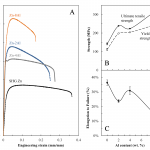Special high grade zinc and wrought zinc-aluminum (Zn-Al) alloys containing up to 5.5 wt% Al were processed, characterized, and implanted in rats in search of a new family of alloys with possible applications as bioabsorbable endovascular stents. The results of findings are published in the article entitled Evaluation of Wrought Zn-Al Alloys (1, 3, and 5 wt% Al) Through Mechanical and In Vivo Testing for Stent Applications published in the Journal of Biomedical Materials Research B: Applied Biomaterials.
These new bioalloys retained roll-induced texture with an anisotropic distribution of the second-phase Al precipitates following hot-rolling, and changes in lattice parameters were observed with respect to Al content. Mechanical properties for the alloys fell roughly in line with strength (190-240 MPa yield strength; 220-300 MPa ultimate tensile strength) and elongation (15-30%) benchmarks, and favorable elastic ranges (0.19-0.27%) were observed. Intergranular corrosion was observed during residence of Zn-Al alloys in the murine aorta, suggesting a different corrosion mechanism than that of pure zinc. This mode of failure needs to be avoided for stent applications because the intergranular corrosion caused cracking and fragmentation of the implants, although the composition of corrosion products was roughly identical between non- and Al-containing materials. In spite of differences in corrosion mechanisms, the cross-sectional reduction of metals in murine aorta was nearly identical at 30-40% and 40-50% after 4.5 and 6 months, respectively, for pure Zn and Zn-Al alloys Histopathological analysis and evaluation of arterial tissue compatibility around Zn-Al alloys failed to identify areas of necrosis, though both chronic and acute inflammatory indications were present.
Publication on Zn-Al Bioalloys
This entry was posted in Publications. Bookmark the permalink.

